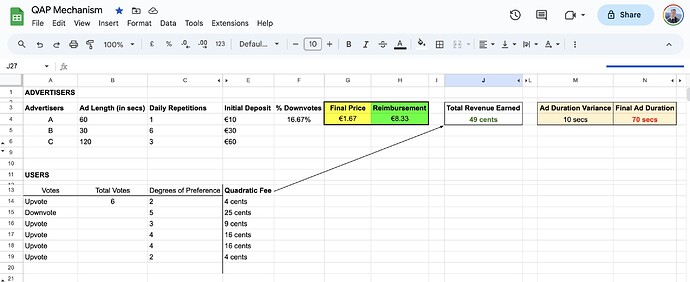I’ve been developing a mechanism around the Quadratic Attention Payments (QAP) concept, which aims to rethink public advertising in important ways. By leveraging quadratic voting principles, this mechanism empowers users to influence the ads they view, incentivizes advertisers to produce higher-quality and more relevant content, offers more accurate — but private — data for publishers, and boosts revenue and rewards for all parties.
Genesis
For greater context into its origin, the initial idea was proposed by Vitalik Buterin on his essay Quadratic Payments: A Primer. In it, he argues that public ads, as a subsector of public goods, are a non-optimal good as the public does not have an efficient way to coordinate in selecting the ads that interest them. Consequently, we end up with a lot of ads we actually don’t want to see.
This is the problem this mechanism tries to solve. Across several iterations, including with Vitalik’s direct feedback, I have matured the mechanism to its current version.
How QAP Can Work
This mechanism empowers:
-
Users to upvote or downvote ads by how many degrees of preference (D) they want. The fee required for voting is equal to D^2, thus quadratic. Users benefit from the gradual improvement in relevance of and better content in ads they see, and earn rewards for their voting participation.
-
Advertisers submit their ads and pool an initial deposit (ID) for their campaign spend. Based on the % of user downvotes on their ad and the quadratic fees (QF), their reimbursement would be calculated as:
Therefore, the actual campaign cost (or amount that stays locked) would be:
Or:
Out of the Final Campaign Cost effectively paid by Advertisers, the platform that implements this mechanism can derive a % for itself and another to be rewarded to participating users. In this system, the monetary and engagement value advertisers get is increased for the same ad expenditure.
- Publishers collect the users’ degrees of preference recorded. This helps them assess the users that the ads most resonated with, and, as a result, how to better instruct Advertisers on how and which users to tailor subsequent ads to. The more efficient the Advertisers’ ads are at generating sustained user attention, the greater the Publishers’s revenue likely becomes.
At the end of the Advertiser’s campaign and after all the user preferences recorded, the ad gets extended or reduced according to the sum of the degrees of preference (D) — positive for upvotes, negative for downvotes:
Looking at the example below, the original duration of Advertiser A’s ad was 60 seconds and the Ad Duration Variance = +10, therefore A’s ad gets extended to a total of 70 seconds.
Users will get to see more of the ads that they value most and advertisers become incentivized to put up better and more valuable ads. The public good is improved through effective public coordination.
Future Roadmap
Experimenting with auction-related Harberger taxation systems, funds pooling and redeeming mechanism, and ZK proofs for secure and unique voting submissions.
In sum
In essence, the Quadratic Attention Payment’s public coordination and compensation system centers around an improved advertising experience for all stakeholders, whilst furthering a user-centric ethos. Particular use cases can include decentralized social networks and platforms with ad-driven products, like the Brave browser.




